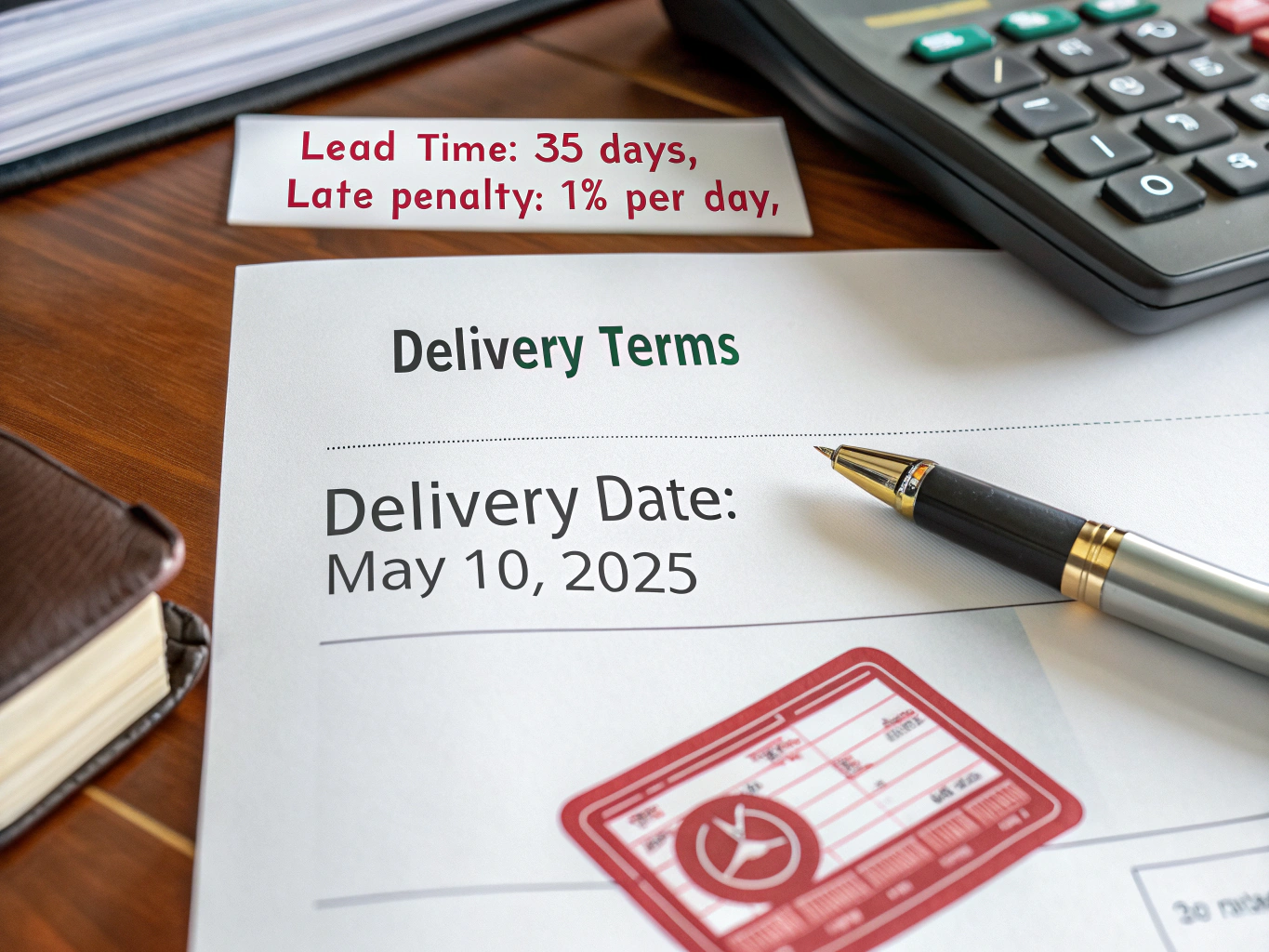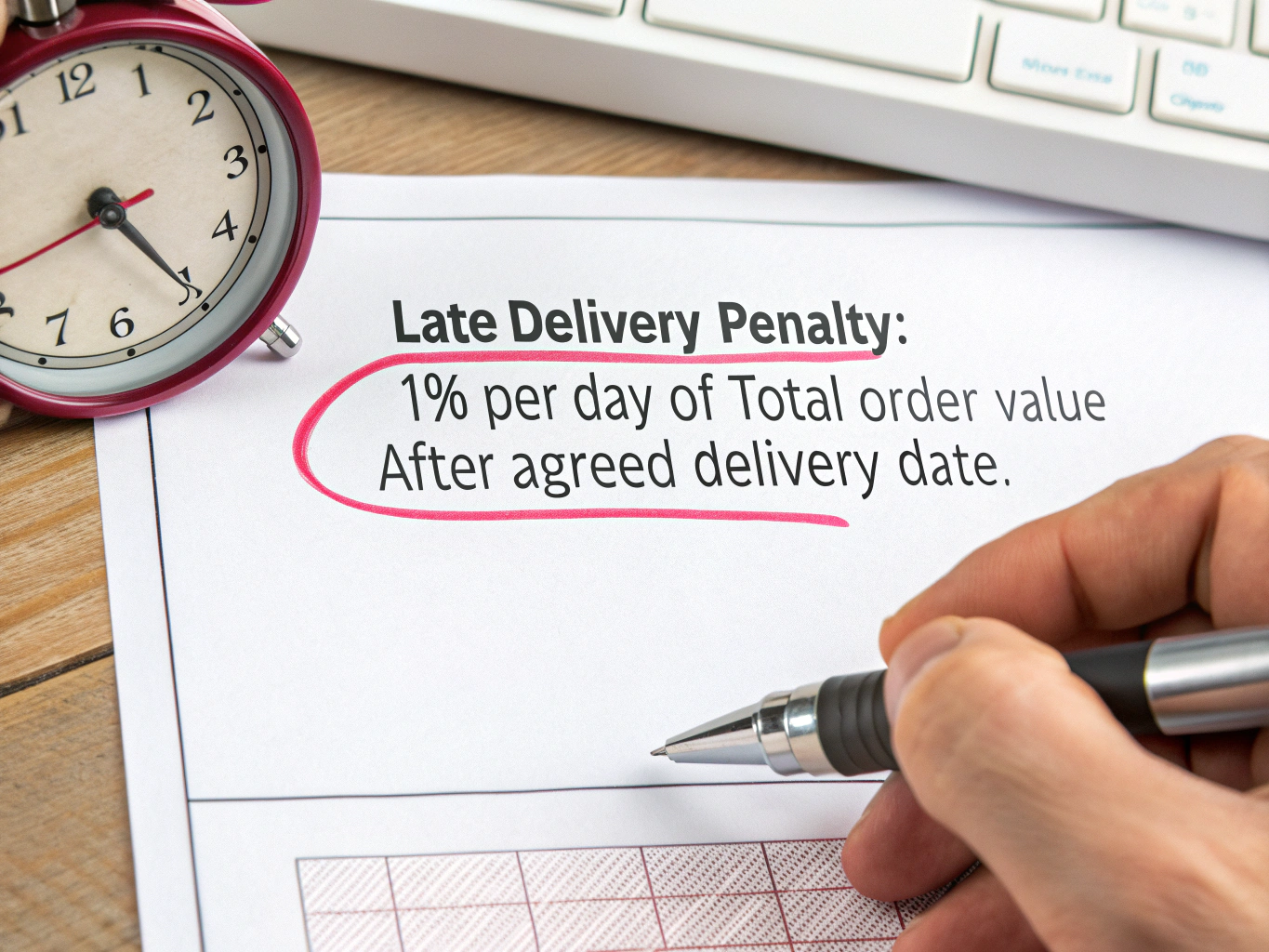
When I experienced my first major delivery delay, it disrupted my customer’s production line and damaged trust. That’s when I realized just how important it is to manage supplier timelines proactively.
Managing delivery delays requires a combination of contract terms, real-time tracking, supplier evaluation, and backup planning to ensure production schedules remain on track.
Ignoring delivery risks can lead to downstream disruptions, financial losses, and customer dissatisfaction. The best approach is to anticipate problems before they occur.
Should penalty clauses for delays be included in the contract?
Late deliveries can cause significant disruptions, especially in just-in-time production environments. Relying only on promises without penalties often leads to missed deadlines.
Yes, contracts should include penalty clauses for late deliveries to incentivize on-time performance and provide compensation for buyer losses.

Clearly defined clauses should specify:
📄 Key Elements of a Penalty Clause
| Clause Element | Description |
|---|---|
| Delay Definition | What qualifies as a delay (e.g., 1 day past delivery date) |
| Penalty Rate | Daily or percentage-based deduction from total order value |
| Grace Period | Allowed buffer period before penalties apply |
| Notification Process | When and how delays must be communicated |
| Cumulative Limit | Maximum total penalty per order |
Penalties must be fair and legally enforceable 1, and suppliers should agree to the terms during negotiation—not after issues arise.
How to establish effective communication for production tracking?
Poor visibility into production often results in last-minute surprises. Email chains and static updates are not enough in fast-moving supply chains.
Effective communication includes real-time dashboards, weekly updates, ERP integration, and shared production timelines to detect issues early.

Setting up structured communication tools builds trust and accountability.
📡 Production Communication Tools
| Method | Benefits |
|---|---|
| Shared Dashboards | Real-time status, visual progress tracking |
| Weekly Progress Reports | Summary of completed vs. pending stages |
| ERP Integration | Direct data sync for larger buyers |
| Chat Groups/Channels | Fast updates and problem-solving |
| Video Calls for Milestones | Clear reviews at critical phases |
Using collaborative production tracking tools 2 improves response times and helps prevent miscommunication during critical stages of production.
Should backup suppliers be considered to mitigate risks?
Relying on a single source for critical parts is risky. Any disruption—whether due to capacity, political issues, or logistics—can bring production to a halt.
Yes, maintaining backup suppliers or dual sourcing essential parts adds resilience and ensures business continuity.

Dual sourcing doesn’t always mean splitting orders. It can be strategic—one primary supplier, one on standby.
🔄 Backup Supplier Planning
| Strategy | Use Case |
|---|---|
| Pre-approved Backup | Same specs, approved and tested in advance |
| Regional Redundancy | Suppliers in different countries for geopolitical risk |
| Tiered Supplier Network | Main and second-tier suppliers in the same category |
| Temporary Emergency Source | Activated only during primary disruption |
A dual sourcing strategy 3 is a smart approach for companies needing flexibility and supply chain resilience.
How to evaluate a supplier’s history of on-time deliveries?
Past performance is one of the best indicators of future reliability. Suppliers with consistent on-time records are less likely to surprise you.
Evaluate delivery history through on-time delivery rates, customer references, case studies, and third-party logistics data.

A well-structured supplier review process makes risk assessment easier.
📊 Supplier Performance Evaluation Checklist
| Metric | Method of Evaluation |
|---|---|
| On-Time Delivery Rate | % of shipments arriving by promised date |
| Customer Feedback | References, testimonials, or ratings |
| Third-Party Data | From freight forwarders or logistics platforms |
| Past Dispute Records | Any claims or complaints filed |
| Internal Audit Results | Factory visit reports or compliance reviews |
Use platforms that provide third-party logistics data 4 to verify supplier reliability and minimize delivery risks.
Conclusion
Preventing delivery delays is not about reacting late—it’s about planning early. With the right contracts, communication, and backup plans, buyers can stay in control and avoid costly surprises.
Footnotes
Explanation of legally enforceable contract penalties like liquidated damages. [#] ↩
Overview of production tracking tools that support real-time manufacturing updates. [#] ↩
Harvard Business Review article on global supply chain resilience and dual sourcing. [#] ↩
Learn how transportation visibility platforms enhance delivery performance insights. [#] ↩

